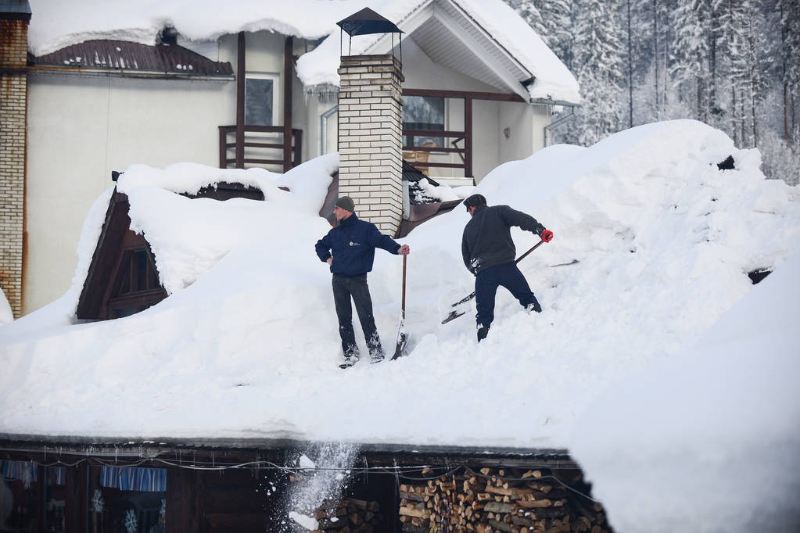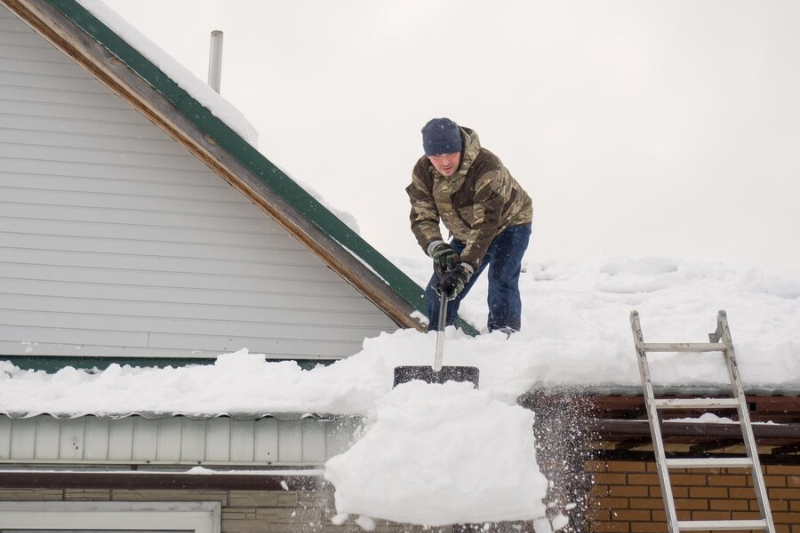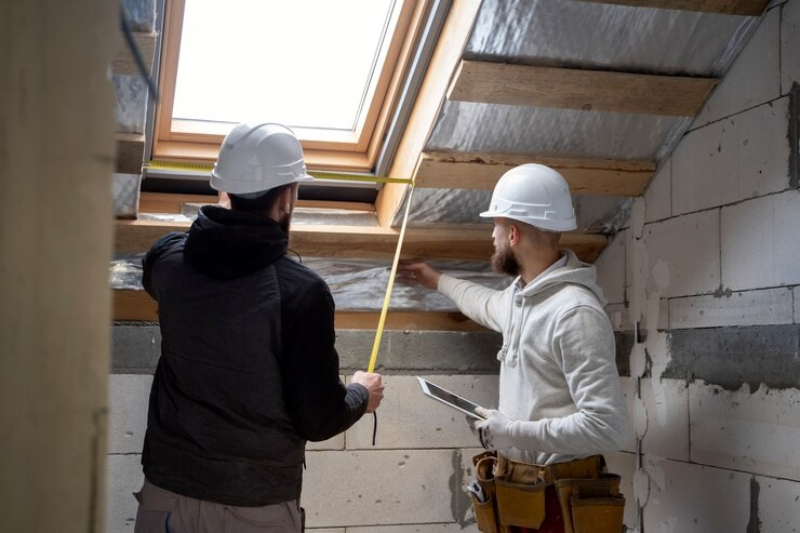Table Of Contents
Dealing with snow and ice on your roof is crucial to conserving the integrity and safety of your home during the cold winter months. Accumulated snow and ice can generate structural damage, ice dams, and even roof collapse if not properly managed. This article offers an exhaustive guide to help you effectively manage and prevent snow and ice build-up on your roof. Read on to learn more!
Understand the risks
Before taking any action, it's essential to understand the risks associated with snow and ice piles on your roof. Heavy snowfall can exert significant weight on your roof, potentially leading to structural damage or collapse. Ice dams, formed when thawed snow refreezes at the roof's edge, can cause water to back up under the shingles, leading to leaks and water damage inside your home.

Assess your roof's snow load capacity
Understanding your roof's snow load capacity is necessary to maintain your home's structural integrity during winter. The snow load capacity refers to the maximum snow and ice your roof can sustain without risking damage. Several factors influence this capacity, and it's crucial to consider each to ensure your roof remains safe and intact throughout the snowy season.
Factors influencing snow load capacity
- Age of Your House: Older structures may have yet to be created to meet current building codes, often including specific snow load requirements based on regional climate data. Further, wear and tear over the years can weaken a roof's structure, reducing its ability to bear heavy loads.
- Roof Design: Your roof's shape and slope significantly affect its snow load capacity. For example, pitched roofs tend to shed snow more efficiently than flat roofs, reducing the risk of heavy snow accumulation. Architectural design, such as the presence of valleys and dormers, can also affect how snow accumulates and how pressure is distributed across the roof.
- Materials Used: Different roofing materials have varying strengths and capacities for snow and ice. For instance, metal roofs might shed snow more easily than asphalt shingle roofs. The underlying structure, including the types of beams and trusses used, also impacts the overall snow load capacity.
- Local Climate and Snow Density: The typical snowfall in your area and the density of the snow are critical factors. Wet snow is much heavier than powdery snow. Building codes often use historical weather data to set minimum standards for snow load capacities in new constructions. Understanding these local nuances is essential for assessing risk.
Preventive measures
Preventing snow and ice accumulation on your roof protects your home's structural integrity and prevents costly repairs. Here are detailed strategies for mitigating the risks associated with snow and ice build-up.

Improve attic insulation and ventilation
Adequate attic insulation and ventilation are critical in maintaining a consistent temperature across the roof's surface, essential for preventing ice dams. Ice dams transpire when heat from the attic causes snow on the roof to melt. The water then flows to the roof's edge, refreezes, and creates a dam that prevents further meltwater from draining, potentially leading to water damage inside the home.
- Insulation: Proper insulation keeps warmth in your living spaces and out of the attic, reducing heat reaching the roof. Ensure that your attic floor is well-insulated to minimize heat loss. Pay special attention to areas around attic stairways, light fixtures, and exhaust fans, where air leaks are common.
- Ventilation: Good attic ventilation allows cold air to enter the attic at the eaves and exit at the peak, helping to keep the roof temperature uniform. Ridge vents, soffit vents, and other roof vents can be installed or upgraded to improve airflow, reducing the risk of ice dam formation.
Install heated cables
Heated cables, or heat tape, can be an effective solution for preventing ice dams. These cables are inaugurated in a zigzag pattern along the roof edge where ice dams typically form.
- Installation: It's crucial to install heated cables before the winter season begins. They should be attached near the roof's edge, in gutters, and downspouts to create channels for meltwater to drain away from the roof.
- Operation: Heated cables are electrically powered and should be turned on before a snowstorm to prevent ice formation. While they are an added expense to your electric bill, their use is temporary and can prevent more costly damage from ice dams.
Regular maintenance
Routine maintenance is vital in preventing snow and ice-related problems. Regular checks and upkeep can identify and rectify potential issues before they escalate into consequential problems.
- Roof Inspection: Inspect your roof for signs of wear, damage, or other topics that may compromise its capability to handle snow and ice. Look for absent or damaged shingles, cracks, and leaks. Early autumn is a good time for this inspection, allowing any necessary repairs before winter.
- Gutter and Downspout Cleaning: Gutters and downspouts free of leaves, twigs, and other debris allow melting snow and ice to flow freely. This prevents water from backing up and freezing at the roof's edge, contributing to ice dam formation. Clean your gutters in late autumn after all the leaves have fallen and again in early spring.
- Trimming Overhanging Branches: Tree branches dangling over your roof can exacerbate snow and ice accumulation and potentially damage your roof during heavy snowfall. Trimming these branches back can reduce the snow on your roof and minimize the risk of damage.
These preventative steps can diminish the risk of snow and ice impairment to your roof. While some steps, like improving insulation and ventilation, demand upfront investment, they can lead to long-term savings by preventing costly repairs and increasing energy efficiency. Regular maintenance and the strategic use of heated cables ensure your roof remains in good condition throughout winter, protecting your home from the elements.
Safe snow and ice removal

Use a roof rake
A roof rake is a tool invented to remove snow from roofs safely. It allows you to stand on the ground while clearing the snow, reducing the risk of injury from falls.
Avoid climbing on the roof
Climbing on a snowy or icy roof is extremely dangerous. If snow and ice removal from the roof cannot be safely accomplished from the ground, consider hiring professionals with the necessary safety gear and experience.
Chemical deicers
Chemical deicers can be used to melt snow and ice on the roof. However, choosing safe products for your roofing material and the environment is essential. Avoid employing rock salt or sodium chloride, which can harm shingles and gutters.
Hire professionals

Given the complexity of factors influencing a roof's snow load capacity, consulting with a structural engineer or a roofing professional is the most reliable way to assess your roof's capability. These experts can perform detailed inspections and calculations to accurately estimate how much snow and ice your roof can safely support.
They may consider the following:
- Inspection of the Roof Structure: A thorough examination of the roof's structural integrity, including the condition of beams, trusses, and the roofing material.
- Analysis of Architectural Plans: If available, reviewing your home's original architectural and engineering plans can offer insights into the designed snow load capacity.
- Application of Building Codes and Standards: Professionals will reference current building codes and standards, which provide guidelines based on regional climate data, to evaluate if your roof meets or exceeds these requirements.
Proactive steps
Based on the assessment, the professional might recommend specific actions to enhance your roof's resilience to heavy snow and ice, such as reinforcing the roof structure, upgrading insulation and ventilation to prevent ice dams, or modifying the roof design for better snow management. Taking proactive steps based on a professional assessment can avoid costly damage and ensure your home remains safe and secure throughout the winter season.
Conclusion
Dealing with snow and ice on your roof is integral to winter home maintenance. By understanding the risks, taking preventive measures, consulting with professionals, and safely removing snow and ice when necessary, you can protect your residence from damage and guarantee the safety of your property. Remember, when in doubt, always consult with or hire professionals to handle the task safely and effectively.




